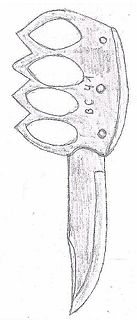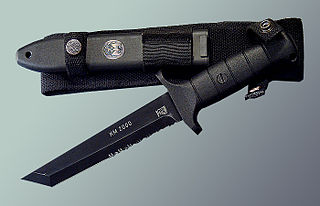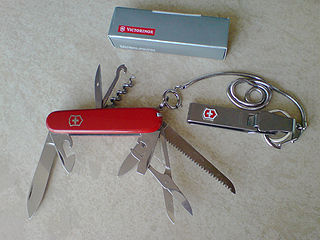 W
WA ballistic knife is a knife with a detachable blade that can be ejected to a distance of several yards by pressing a trigger or operating a lever or switch on the handle. Spring-powered ballistic knives first appeared in books and press reports on Soviet and Eastern Bloc armed forces in the late 1970s. Commercially-produced ballistic knives briefly gained notoriety in the United States in the mid-1980s after they were marketed and sold in the United States and other Western countries. Since then, the marketing and sale of ballistic knives to civilians has been restricted or prohibited by law in several nations.
 W
WThe BC-41 was a combined knuckleduster and dagger weapon used by the British Commandos during World War II for close combat and ambush situations. Although effective, it was eventually replaced by the Fairbairn-Sykes Fighting Knife.
 W
WA combat knife is a fighting knife designed solely for military use and primarily intended for hand-to-hand or close combat fighting.
 W
WThe Commander (knife) is a large recurve folding knife made by Emerson Knives, Inc. that was based on a custom design, the ES1-M, by Ernest Emerson that he originally built for a West Coast Navy SEAL Team. It was winner of the Blade Magazine Overall Knife of the Year Award for 1999.
 W
WThe Corvo is a bladed weapon typically used in Chile. It is a double-edged knife with a curved blade of approximately 12 inches. Initially a tool similar to a grape hook, it was widely used in combat during the War of the Pacific. It was not standard issue, but rather a personal weapon or tool that the soldiers brought with them from home.
 W
WThe Fairbairn–Sykes fighting knife is a double-edged fighting knife resembling a dagger or poignard with a foil grip developed by William Ewart Fairbairn and Eric Anthony Sykes in Shanghai based on ideas which the two men had before World War II while serving on the Shanghai Municipal Police in China.
 W
WThe French Nail were locally fabricated and converted bayonets, knives and stabbing weapons for use in the First World War. These were crude stabbing spikes made by adding a point to a steel stake which had its rearmost section heated and bent into a crude handle.
 W
WThe Glock knife is a military field knife product line designed and produced by Glock Ges.m.b.H., located in Deutsch-Wagram, Austria. It can also be used as a bayonet, by engaging a socket in the pommel into a bayonet adapter that can be fitted to the Steyr AUG rifle.
 W
WKa-Bar is the contemporary popular name for the combat knife first adopted by the United States Marine Corps in November 1942 as the 1219C2 combat knife, and subsequently adopted by the United States Navy as the U.S. Navy utility knife, Mark 2. Additionally, Ka-Bar is the name of a related knife manufacturing company, Ka-Bar Knives., Inc., of Olean, New York, a subsidiary of the Cutco Corporation.
 W
WThe KM2000 is the standard combat knife of the German Bundeswehr, mostly used by the German Army. The knife is manufactured in Germany by the Eickhorn-Solingen company.
 W
WThe kukri or khukuri is a type of machete originating from the Indian subcontinent, and is traditionally associated with the Nepali-speaking Gurkhas of Nepal and India. The knife has a distinct recurve in its blade. It serves multiple purposes as a melee weapon and also as a regular cutting tool throughout most of South Asia. The blade has traditionally served the role of a basic utility knife for the Gurkhas. The kukri is the national weapon of Nepal, and consequently is a characteristic weapon of the Nepalese Army. The kukri also sees standard service with various regiments and units within the Indian Army, such as the Assam Rifles, the Kumaon Regiment, the Garhwal Rifles and the various Gorkha regiments. Outside of its native region of South Asia, the kukri also sees service with the Royal Gurkha Rifles of the British Army—a unique regiment that is quite different from the rest of the British Army as it is the only regiment that recruits its soldiers strictly from Nepal; a relationship that has its roots in the times of British colonial rule in India. The kukri is the staple weapon of all Gurkha military regiments and units throughout the world, so much so that some English-speakers refer to the weapon as a "Gurkha blade" or "Gurkha knife". The kukri often appears in Nepalese and Indian Gorkha heraldry and is used in many traditional, Hindu-centric rites such as wedding ceremonies.
 W
WThe M3 fighting knife or M3 trench knife was an American military combat knife first issued in March 1943. The M3 was originally designated for issue to soldiers not otherwise equipped with a bayonet. However, it was particularly designed for use by forces in need of a close combat knife, such as Airbornes and Army Rangers, so these units received priority for the M3 at the start of production. As more M3 knives became available in 1943 and 1944, the knife was issued to other soldiers such as Army Air Corps crewmen and soldiers not otherwise equipped with a bayonet, including soldiers issued the M1 Carbine or submachine gun.
 W
WThe Mark I trench knife is an American trench knife designed by officers of the American Expeditionary Force (AEF) for use in World War I. It has a 6.75 in (17.1 cm) double-edged dagger blade useful for both thrusting and slashing strokes, unlike previous U.S. trench knives such as the M1917 and M1918. The handle is made of cast bronze and uses a conical steel nut to hold the blade in place. The Mark I's blade was blued with a black oxide finish, the bronze handle was chemically blackened, with cast spikes on the bow of each knuckle. The spikes were intended to prevent an opponent from grabbing the knife hand, as well as to provide a more concentrated striking surface when employed in hand-to-hand combat.
 W
WThe OKC-3S is a bayonet developed by the United States Marine Corps to replace the M7 bayonet and M9 bayonet as its service bayonet for the M16 family of rifles and M4 series carbine. This multipurpose bayonet provides greater durability than the M7 and also functions as a fighting knife.
 W
WThe pugio was a dagger used by Roman soldiers as a sidearm. It seems likely that the pugio was intended as an auxiliary weapon, but its exact purpose to the soldier remains unknown. Officials of the empire took to wearing ornate daggers in the performance of their offices, and some would wear concealed daggers as a defense against contingencies. The dagger was a common weapon of assassination and suicide; for example, the conspirators who stabbed Julius Caesar used pugiones. The pugio was descended from the daggers used by the Cantabarians.
 W
WThe SARK or NSAR is a folding knife designed by knifemaker Ernest Emerson for use as a search and rescue knife by the US military. It has a hawkbill with a blunt tip in order to cut free trapped victims without cutting them in the process. There is a variant with a pointed-tip designed for police, known as the P-SARK.
 W
WThe SOG knife was designed for, and issued to, covert Studies and Observations Group personnel during the Vietnam War. It was unmarked and supposedly untraceable to country of origin or manufacture in order to maintain plausible deniability of covert operators in the event of their death or capture.
 W
WThe Swiss Army knife is a multi-tool pocketknife manufactured by Victorinox. The term "Swiss Army knife" was coined by American soldiers after World War II due to the difficulty they had in pronouncing "Offiziersmesser", the German name.
 W
WThe Strider SMF is a framelock folding knife that was specifically developed for Det One, the first unit of the United States Marine Corps (USMC) under the United States Special Operations Command (SOCOM). The Strider SMF was the first knife issued to an individual USMC unit in over 60 years and the first tactical folder issued within the USMC.
 W
WA tantō is one of the traditionally made Japanese swords (nihonto) that were worn by the samurai class of feudal Japan. The tantō dates to the Heian period, when it was mainly used as a weapon but evolved in design over the years to become more ornate. Tantō were used in traditional martial arts (tantojutsu). The term has seen a resurgence in the West since the 1980s as a point style of modern tactical knives, designed for piercing or stabbing.
 W
WA trench knife is a combat knife designed to kill or incapacitate an enemy at close quarters, such as in a trench or other confined area. It was developed as a close combat weapon for soldiers attacking enemy trenches during the First World War. An example of a World War I trench knife is the German Army's Nahkampfmesser.
 W
WThe V-42 stiletto was a stiletto and fighting knife issued during World War II to the First Special Service Force, a joint American/Canadian commando unit.